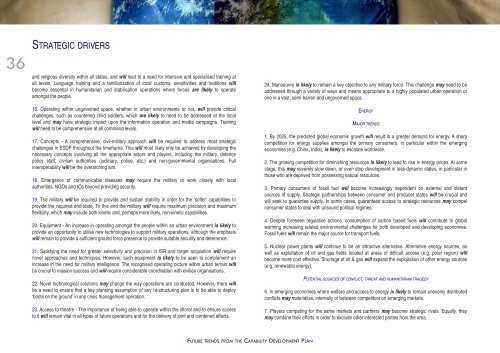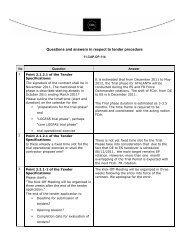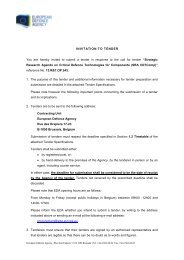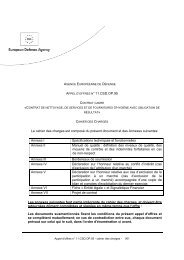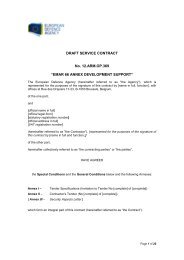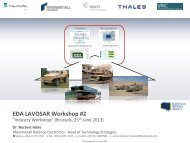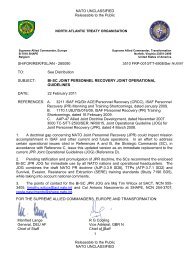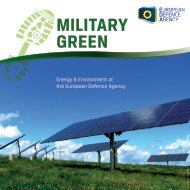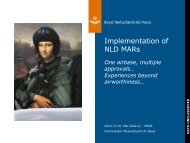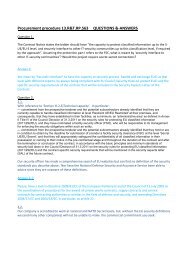capability development plan - European Defence Agency - Europa
capability development plan - European Defence Agency - Europa
capability development plan - European Defence Agency - Europa
You also want an ePaper? Increase the reach of your titles
YUMPU automatically turns print PDFs into web optimized ePapers that Google loves.
36<br />
STRATEGIC DRIVERS<br />
and religious diversity within all states, and will lead to a need for intensive and specialised training at<br />
all levels. Language training and a familiarisation of local customs, sensitivities and traditions will<br />
become essential in humanitarian and stabilisation operations where forces are likely to operate<br />
amongst the people.<br />
16. Operating within ungoverned space, whether in urban environments or not, will provide critical<br />
challenges, such as countering child soldiers, which are likely to need to be addressed at the local<br />
level and may have strategic impact upon the information operation and media campaigns. Training<br />
will need to be comprehensive at all command levels.<br />
17. Concepts - A comprehensive, civil-military approach will be required to address most strategic<br />
challenges in ESDP throughout the timeframe. This will most likely only be achieved by developing the<br />
necessary concepts involving all the appropriate actors and players, including the military, defence<br />
policy staff, civilian authorities (judiciary, police, etc.) and non-governmental organisations. Full<br />
interoperability will be the overarching aim.<br />
18. Emergence of communicable diseases may require the military to work closely with local<br />
authorities, NGOs and IOs beyond providing security.<br />
19. The military will be required to provide and sustain stability in order for the ‘softer’ capabilities to<br />
provide the required end-state. To this end the military will require maximum precision and maximum<br />
flexibility, which may include both kinetic and, perhaps more likely, non-kinetic capabilities.<br />
20. Equipment - An increase in operating amongst the people within an urban environment is likely to<br />
provide an opportunity to utilise new technologies to support military operations, although the emphasis<br />
will remain to provide a sufficient ground force presence to provide suitable security and deterrence.<br />
21. Satisfying the need for greater selectivity and precision in ISR and target acquisition will require<br />
novel approaches and techniques. However, such equipment is likely to be seen to complement an<br />
increase in the need for military intelligence. The recognised operating picture within urban terrain will<br />
be crucial to mission success and will require considerable coordination with civilian organisations.<br />
22. Novel technological solutions may change the way operations are conducted. However, there will<br />
be a need to ensure that a key <strong>plan</strong>ning assumption of any re-structuring <strong>plan</strong> is to be able to deploy<br />
‘boots on the ground’ in any crisis management operation.<br />
23. Access to theatre - The importance of being able to operate within the littoral and to ensure access<br />
to it will remain vital in all types of future operations and for the delivery of joint and combined effects.<br />
24. Manoeuvre is likely to remain a key objective to any military force. This challenge may need to be<br />
addressed through a variety of ways and means appropriate to a highly populated urban operation or<br />
one in a vast, semi-barren and ungoverned space.<br />
ENERGY<br />
MAJOR TRENDS<br />
1. By 2025, the predicted global economic growth will result in a greater demand for energy. A sharp<br />
competition for energy supplies amongst the primary consumers, in particular within the emerging<br />
economies (e.g. China, India), is likely to escalate worldwide.<br />
2. The growing competition for diminishing resources is likely to lead to rise in energy prices. At some<br />
stage, this may severely slow down, or even stop <strong>development</strong> in less-dynamic states, in particular in<br />
those who are deprived from possessing natural resources.<br />
3. Primary consumers of fossil fuel will become increasingly dependent on external and distant<br />
sources of supply. Strategic partnerships between consumer and producer states will be crucial and<br />
will seek to guarantee supply. In some cases, guaranteed access to strategic resources may compel<br />
consumer states to deal with unsound political regimes.<br />
4. Despite foreseen regulative actions, consumption of carbon based fuels will contribute to global<br />
warming increasing related environmental challenges for both developed and developing economies.<br />
Fossil fuels will remain the major source for transport fuels.<br />
5. Nuclear power <strong>plan</strong>ts will continue to be an attractive alternative. Alternative energy sources, as<br />
well as exploitation of oil and gas fields located at areas of difficult access (e.g. polar region) will<br />
become more cost effective. Shortage of oil & gas will expand the exploitation of other energy sources<br />
(e.g. renewable energy).<br />
POTENTIAL SOURCES OF CONFLICT, THREAT AND HUMANITARIAN TRAGEDY<br />
6. In emerging economies where welfare and access to energy is likely to remain unevenly distributed<br />
conflicts may materialise, internally or between competitors on emerging markets.<br />
7. Players competing for the same markets and partners may become strategic rivals. Equally, they<br />
may combine their efforts in order to exclude other interested parties from the area.<br />
FUTURE TRENDS FROM THE CAPABILITY DEVELOPMENT PLAN


